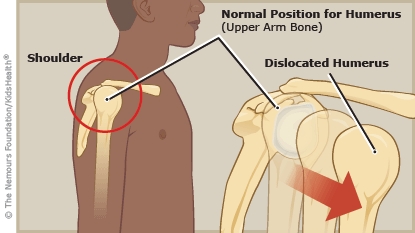Dislocated Shoulder: How to Care for Your Child
A dislocated shoulder is when the upper arm bone (humerus) comes out of the shoulder socket. This usually causes severe pain, swelling, and trouble moving the shoulder.
After the health care provider puts the bone back into place (called a reduction), the shoulder is held in place by an immobilizer. Physical therapy is needed to rebuild strength and movement.
Sometimes surgery is needed to treat a dislocated shoulder (for example, if the upper arm bone can't be put back into place, there are other injuries, or if someone gets a lot of shoulder dislocations).
Usually, kids return to most everyday activities within a couple of months, although a return to sports can take longer.


Help your child follow the health care provider's advice for:
-
Taking any pain medicines.
-
Wearing the immobilizer, including when to wear it and for how long.
-
Any exercises or stretches to do. These are very important to prevent the shoulder from getting "frozen" (unable to move).
-
Going to see a bone doctor (orthopedist), sports medicine doctor, and physical therapist to help them build strength and flexibility and create a plan for returning to full activities and sports.
-
When they can go back to full activities and sports and if they need any special equipment or supports.
-
When to follow up.
General care:
-
If your child had sedation (medicine to make them relax and not feel pain) for the reduction, they may be sleepy. Let them rest as needed.
-
To help with pain and swelling in the first few days:
-
Put ice wrapped in a towel to the shoulder several times a day for up to 15–20 minutes at a time. Do not place ice directly on the skin.
-
You can give acetaminophen (Tylenol® or a store brand) or ibuprofen (Advil®, Motrin®, or a store brand). Follow the package directions for how much to give and how often.

Your child has:
-
numbness or tingling in the arm or hand
-
new pain, swelling, or bruising in the arm

Your child:
-
dislocates the shoulder again
-
has extreme pain or swelling
-
has a blue or cold hand
-
can't move the hand or fingers

What causes a shoulder dislocation? In kids and teens, it usually happens from a fall or a sports-related accident. It can also happen from trauma (for example, from a car accident).
Can my child get another shoulder dislocation? Having one shoulder dislocation makes having another more likely. To prevent another dislocated shoulder, it may help to be sure your child:
-
is fully recovered from the dislocated shoulder before going back to all activities
-
continues any strengthening exercises
-
wears a shoulder support (if recommended by your health care provider)
-
warms up before sports activities
-
is active year-round, which will help their shoulders and the rest of their body stay in good shape
What should we do if the shoulder dislocates again? Have your child keep the shoulder very still (use a sling, if possible), put ice on the shoulder, and go to an emergency room right away. It's best to put the shoulder back into place as soon as possible.